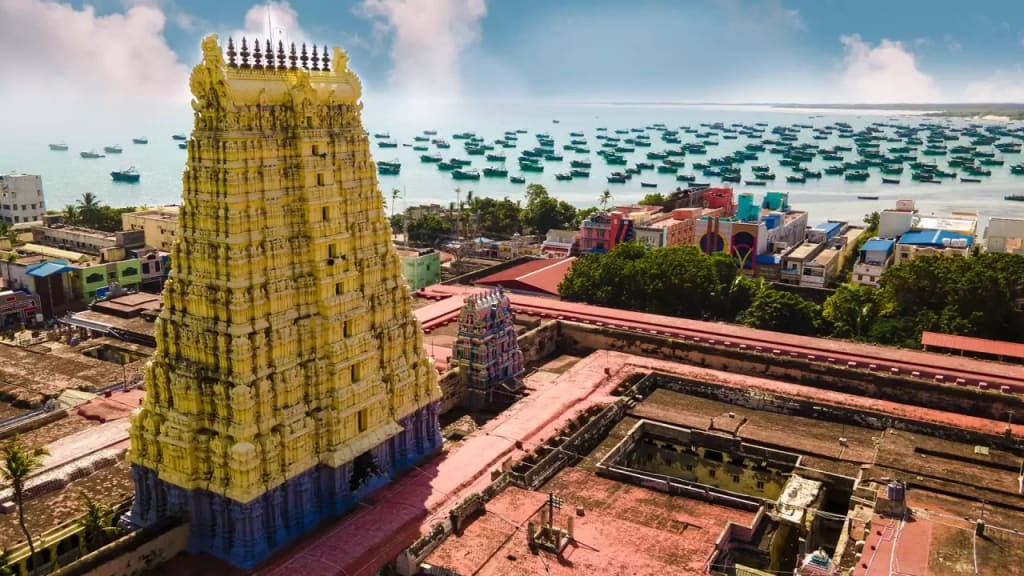
Ramanathaswamy Temple: A Sacred Pilgrimage Destination in India
India is renowned for its deep cultural history, which is represented by a vast array of temples, monuments, and shrines. Ramanathaswamy Temple stands out as one of the most major pilgrimage destinations in India among these holy sites. This historic temple honouring Lord Shiva is situated on the island of Rameswaram in Tamil Nadu and draws many visitors each year.
History of Ramanathaswamy Temple
The Pandya dynasty constructed the Ramanathaswamy Temple in the 12th century, which is when it first appeared in history. Over the ages, the temple has been enlarged and restored by a number of kings and dynasties, including the Chola, Vijayanagara, and Nayak empires. The Dravidian style of temple construction is evident in the temple's exquisite architecture, which is well-known.
According to legend, after returning from Lanka victorious, Lord Rama, the seventh manifestation of Lord Vishnu, built a Shivalinga at Rameswaram. He offered Lord Shiva a puja (ritual devotion) in order to obtain his blessings for defeating Ravana. In accordance with a different myth, Lord Rama requested that Lord Hanuman bring a Shivalinga from Kashi (Varanasi) to Rameswaram. Sita, Lord Rama's wife, created a Shivalinga out of sand, which Lord Rama installed and worshipped, as Lord Hanuman could not arrive before the blessed time for installation. The installation of the Ramanathaswamy Jyotirlinga is commemorated by this day.
The Temple Architecture
One of the biggest temples in India, the Ramanathaswamy Temple is stretched across 15 acres. A number of shrines, mandapams (halls), gopurams (towers), and tanks make up the temple complex. The Ramanathaswamy Jyotirlinga, one of India's twelve Jyotirlingas, is kept in the temple's main shrine. Many smaller shrines honouring various gods surround the sanctum.
The beautifully carved pillars, arches, and sculptures of the temple serve as a magnificent example of Dravidian architecture. The gopurams (towers) of the temple are also notable for their fine sculptures and vivid colours. On the eastern side of the temple, the biggest gopuram is 53 meters high and has 11 stories. Intricate carvings that represent episodes from Hindu mythology adorn the gopuram.
A number of mandapams (halls) in the temple complex are also used for various religious and cultural purposes. The 1000-pillar mandapam, the most well-known of these mandapams, is famed for its magnificent carvings and distinctive acoustics. The mandapam is built in such a way that all of its pillars can hear the sound of striking one of them.
The Temple's Religious Significance
Hindus worship the Ramanathaswamy Temple as a place of salvation and see it as one of the holiest locations on earth. Hindu mythology holds that taking a bath in the holy tanks of the temple will wash away one's sins and bring salvation. A lot of worshippers visit the temple during significant Hindu holidays including Mahashivratri, Navratri, and Diwali.
The Maha Shivaratri Brahmotsavam festival at Ramanathaswamy Temple:
The Ramanathaswamy Temple's most significant event is the Maha Shivaratri Brahmotsavam. The event lasts for 10 days, culminating on the day of Maha Shivaratri, during the Tamil month of Masi (February–March).
On the first day of the festival, the temple flag is raised. The procession idol of Lord Ramanathaswamy is ceremoniously bathed in the neighbouring sea on the second day. The Sethu Snanam (bath in the bridge) is the name of the ritual, which denotes the purification of both the body and the soul.
The utsava murthy is brought back to the temple on the third day and is driven in an adorned chariot in a parade around the temple. The major deity is ceremonially bathed as part of the festival's ongoing rites and celebrations, which also include Vedic hymn chanting and the presentation of diverse cultural performances.
On the night of Maha Shivaratri, the temple is illuminated and throngs of worshippers congregate to pray to Lord Shiva. Devotees are permitted to see the deity by entering the main sanctum, which is open all through the night. On the tenth day, the temple flag is lowered to mark the end of the festival.
Attracting lakhs of devotees from around the nation, the Ramanathaswamy Temple's Maha Shivaratri Brahmotsavam celebration is a magnificent occasion. The event, which is observed with tremendous passion and excitement, is evidence of India's extensive cultural and religious legacy.
Attracting lakhs of devotees from around the nation, the Ramanathaswamy Temple's Maha Shivaratri Brahmotsavam celebration is a magnificent occasion. The event, which is observed with tremendous passion and excitement, is evidence of India's extensive cultural and religious legacy.
In addition to the Maha Shivaratri Brahmotsavam, the temple also observes Panguni Uthiram, Navaratri, and Diwali throughout the year. These holidays are observed with comparable pomp and splendour and draw a sizable following.
The Ramanathaswamy Temple has historical significance in addition to its religious value. Throughout the mediaeval era, the temple served as a hub of study and cultural patronage, and a lot of academics and painters came here to exhibit their work. Many independence fighters sought refuge at the temple under the British Raj, and thus played a vital part in the temple's contribution to the Indian freedom war.
Visiting Ramanathaswamy Temple
On the island of Rameswaram, which is connected to the mainland by a bridge, sits the Ramanathaswamy Temple. The closest airport is in Madurai, about 170 kilometers away. Train service is another option for getting to the temple, with Rameswaram serving as a significant rail hub.
From early in the morning until late at night, the temple is open to guests, who are expected to adhere to strict dress requirements and practises. Inside the temple grounds, photography is absolutely forbidden.
In conclusion
In India, a major pilgrimage site known for its exquisite construction, long history, and religious significance is the Ramanathaswamy Temple. The temple's yearly Maha Shivaratri Brahmotsavam celebration is a great occasion that draws thousands of devotees from all across the nation and serves as a reminder of India's rich religious and cultural legacy. A look into the nation's rich cultural and religious legacy can be had via a trip to the Ramanathaswamy Temple.






Comments
There are no comments for this story
Be the first to respond and start the conversation.